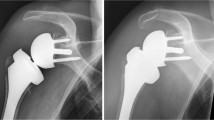Abstract
Purpose
Scapular stress fracture (sSF) is a difficult complication to treat after reverse total shoulder arthroplasty (RSA). The aim of this study was to identify the prevalence and possible risk factors in a large population.
Methods
A total of 2165 RSAs that were implanted between January 2006 and October 2017 in five hospitals were evaluated. Within this cohort, sSF was radiologically confirmed. Age, gender, surgical indication and hospital of treatment were determined for the entire cohort. A matched 3:1 case-control study was then performed to investigate several clinical and surgical variables.
Results
sSF occurred in 3.1% (63 patients), with a median time interval of five months post-operative [IQR = 9, range: (1–79)]. Within the entire cohort, females (OR = 2.99) and rotator cuff arthropathy (RCA) (OR = 2.79) were more prone to this complication. Age had little influence (OR = 1.03). After exclusion, fifty-five eligible cases were matched to 165 controls based on hospital, gender, age and surgical indication. After univariable analysis, significance was obtained for osteopenia (P = 0.037), osteoporosis (P = 0.032), surgical approach (P = 0.002) and peri-operative acromioclavicular (AC) joint surgery (P = 0.035). Multivariate analysis demonstrated that osteopenia (OR = 3.94), osteoporosis (OR = 2.85) and a deltopectoral approach (OR = 3.70) were independent risk factors.
Conclusion
According to our findings, older women with poor bone quality and a history of RCA suffered more frequently from sSF. Anterolateral approach during surgery was a surgical protective factor, possibly due to the mobilization of the acromioclavicular joint. Although this study indicates who is at risk for sSF, further investigation for prevention of sSF in these patients is necessary.






Similar content being viewed by others
Data availability
Not applicable.
References
Boileau P, Watkinson DJ, Hatzidakis AM, Balg F (2005) Grammont reverse prosthesis: design, rationale, and biomechanics. J Shoulder Elb Surg 14(1 Suppl S):147–161. https://doi.org/10.1016/j.jse.2004.10.006
Berliner JL, Regalado-Magdos A, Ma CB, Feeley BT (2015) Biomechanics of reverse total shoulder arthroplasty. J Shoulder Elb Surg 24(1):150–160. https://doi.org/10.1016/j.jse.2014.08.003
Ascione F, Kilian CM, Laughlin MS, Bugelli G, Domos P, Neyton L et al (2018) Increased scapular spine fractures after reverse shoulder arthroplasty with a humeral onlay short stem: an analysis of 485 consecutive cases. J Shoulder Elb Surg 27(12):2183–2190. https://doi.org/10.1016/j.jse.2018.06.007
Mayne IP, Bell SN, Wright W, Coghlan JA (2016) Acromial and scapular spine fractures after reverse total shoulder arthroplasty. Shoulder Elbow 8(2):90–100. https://doi.org/10.1177/1758573216628783
Crosby LA, Hamilton A, Twiss T (2011) Scapula fractures after reverse total shoulder arthroplasty: classification and treatment. Clin Orthop Relat Res 469(9):2544–2549. https://doi.org/10.1007/s11999-011-1881-3
Hamid N, Connor PM, Fleischli JF, D’Alessandro DF (2011) Acromial fracture after reverse shoulder arthroplasty. Am J Orthop (Belle Mead NJ), 40(7): p. 125–9. Available from: http://www.ncbi.nlm.nih.gov/pubmed/22013577
Dubrow S, Streit JJ, Muh S, Shishani Y, Gobezie R (2014) Acromial stress fractures: correlation with acromioclavicular osteoarthritis and acromiohumeral distance. Orthopedics 37(12):1074–1079. https://doi.org/10.3928/01477447-20141124-54
Hattrup SJ (2010) The influence of postoperative acromial and scapular spine fractures on the results of reverse shoulder arthroplasty. Orthopedics 33(5). https://doi.org/10.3928/01477447-20100329-04
Teusink MJ, Otto RJ, Cottrell BJ, Frankle MA (2014) What is the effect of postoperative scapular fracture on outcomes of reverse shoulder arthroplasty? J Shoulder Elb Surg 23(6):782–790. https://doi.org/10.1016/j.jse.2013.09.010
Walch G, Mottier F, Wall B, Boileau P, Molé D, Favard L et al (2009) Acromial insufficiency in reverse shoulder arthroplasties. J Shoulder Elb Surg 18(3):495–502. https://doi.org/10.1016/j.jse.2008.12.002
Levy JC, Anderson C, Samson A (2013) Classification of postoperative acromial fractures following reverse shoulder arthroplasty. J Bone Jt Surg Am 95(15):104. https://doi.org/10.2106/JBJS.K.01516
Neyton L, Erickson J, Ascione F, Bugelli G, Lunini E, Walch G et al (2018) Scapular fractures in reverse shoulder arthroplasty (Grammont style): prevalence, functional, and radiographic results with minimum 5-year follow-up. J Shoulder Elb Surg 28(2):260–267. https://doi.org/10.1016/j.jse.2018.07.004
Kupper LL, Karon JM, Kleinbaum DG, Morgenstern H, Lewis DK (1981) Matching in epidemiologic studies: validity and efficiency considerations. Biometrics 37(2):271–291
Pearce N (1981) Analysis of matched case-control studies. BMJ 352:i969. https://doi.org/10.1136/bmj.i969
Levy JC, Anderson C, Samson A (2013) Classification of postoperative acromial fractures following reverse shoulder arthroplasty. J Bone Joint Surg Am 95(15):e104. https://doi.org/10.2106/JBJS.K.01516
Kennon JC, Lu C, McGee-Lawrence ME, Crosby LA (2017) Scapula fracture incidence in reverse total shoulder arthroplasty using screws above or below metaglene central cage: clinical and biomechanical outcomes. J Shoulder Elb Surg 26(6):1023–1030. https://doi.org/10.1016/j.jse.2016.10.018
Otto RJ, Virani NA, Levy JC, Nigro PT, Cuff DJ, Frankle MA (2013) Scapular fractures after reverse shoulder arthroplasty: evaluation of risk factors and the reliability of a proposed classification. J Shoulder Elb Surg 22(11):1514–1521. https://doi.org/10.1016/j.jse.2013.02.007
Werthel J-D, Schoch BS, van Veen SC, Elhassan BT, An K-N, Cofield RH, et al., (2018) Acromial fractures in reverse shoulder arthroplasty: a clinical and radiographic analysis. J Shoulder Elb Arthroplast. https://doi.org/10.1177/2471549218777628
McNerny EMB, Nickolas TL (2018) Bone quality in chronic kidney disease: definitions and diagnostics. Curr Osteoporos Rep 15(3):207–213. https://doi.org/10.1007/s11914-017-0366-z
Molé D, Wein F, Dézaly C, Valenti P, Sirveaux F (2011) Surgical technique: the anterosuperior approach for reverse shoulder arthroplasty. Clin Orthop Relat Res 469(9):2461–2468. https://doi.org/10.1007/s11999-011-1861-7
Author information
Authors and Affiliations
Corresponding author
Ethics declarations
Conflict of interest
The authors declare that they have no conflict of interest.
Code availability
Not applicable.
Additional information
Publisher’s note
Springer Nature remains neutral with regard to jurisdictional claims in published maps and institutional affiliations.
Level of evidence: Level 3; therapeutic retrospective case control study
Rights and permissions
About this article
Cite this article
Verstraete, O., Van der Mast, B., Van Tongel, A. et al. Prevalence and risk factors of scapular stress fracture after reverse shoulder arthroplasty: a multicentric retrospective study. International Orthopaedics (SICOT) 45, 209–216 (2021). https://doi.org/10.1007/s00264-020-04849-7
Received:
Accepted:
Published:
Issue Date:
DOI: https://doi.org/10.1007/s00264-020-04849-7




